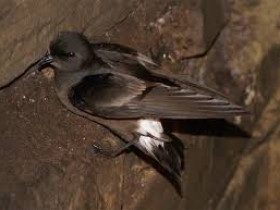Storm Petrel
Hydrobates pelagicus
14-18cm
Appearance of the Storm Petrel
The small size of this bird is a spectacle when it's dipping and soaring near huge waves. It is Britain's smallest seabird, only slightly bigger than a sparrow. Its plumage is sooty-black, its rump white, and it has a white patch above the tail that spreads around the sides. The underwing is also marked with white, a broad stripe down the centre; the wings are relatively shorter than other petrels, and the tail is short too with a square end. Juvenile birds resemble adults, however the first autumn usually sees a pale section on the upperwing.
Storm Petrel Habitat
Mainly breeds on the west coast of Britain and in Ireland, opting for islands facing the Atlantic; more generally, remote islands with minimal predators are preferred. Rocky outcrops, boulders, walls or ruined buildings with crevices are ideal spots for nesting, and these sites are usually close to deep water.
Character
Breeding season brings the bird to land at night, but at other times it prefers the open ocean. It has a quick flap of the wing and feeds with its wings in a V, its feet tapping the water's surface. It can feed in large flocks and also associates with other feeding seabirds; it may also follow the path of sea vessels. It is a powerful flier, appearing unhindered by strong winds.
What does the Storm Petrel eat?
Diet is predominately small fish, such as sprats and herring, plankton, jellyfish and small crustaceans and squid. Waste from sea vessels is also taken advantage of.
Storm Petrel Breeding
Both adults share the duty of incubating one egg; they take turns, each stint lasting approximately 3 days. The egg hatches after about 40 days, and the chick is brooded for a week, then its parents leave intermittently to search for food, which they regurgitate to the chick at night. Young birds leave their burrow at around 62 days; they make their way to the open ocean.
Population
Majority of British and Irish breeding birds depart coastal waters in September and October. There are approximately 26 000 birds in the UK and 99 000 pairs nest in Britain and Ireland.
Observation Tips for the Storm Petrel
Ferry routes on the Irish Sea, and from mainland Scotland to Shetland and the Outer Hebrides may provided sightings from April to August. Alternatively, strong winds sometimes force these birds closer to west-facing headlands than normal in August and September.
Voice
Mostly silent except at breeding sites where it utters a purring, gurgling call.


